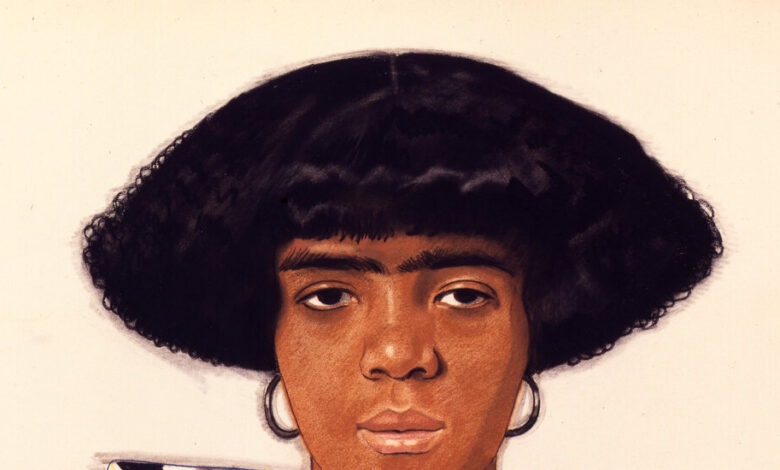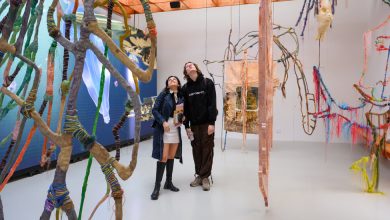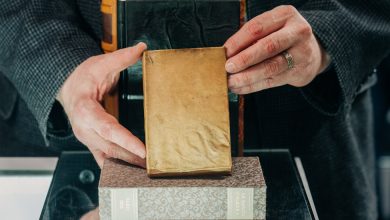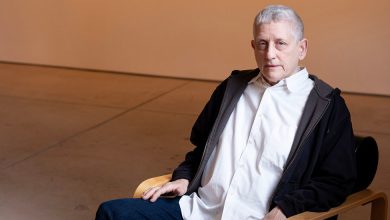Winold Reiss, an Immigrant Modernist Way Ahead of His Time

In 1925, a German immigrant named Winold Reiss was invited to design and illustrate an issue of the journal Survey Graphic devoted to Harlem, the new cultural capital of Black America. So he got together his conté crayons and pastels and went uptown to draw Langston Hughes, Zora Neale Hurston, James Weldon Johnson and other eminences of what would come to be called the Harlem Renaissance, along with various of their less famous neighbors.
After the magazine was printed, though, his gallery, otherwise doing a brisk business for him, refused to show the work. In “The Art of Winold Reiss: An Immigrant Modernist” at the New-York Historical Society, his sensitive, humane, occasionally brilliant Harlem portraits get their first museum showing here since appearing at the 135th Street Harlem Branch of the New York Public Library nearly a century ago.
The son and grandson of illustrators and lithographers, Reiss (1886-1953) studied fine art in Munich, but he paid his way with commercial jobs in portraiture and advertising. In 1913, art markets in Germany were contracting and Reiss moved to New York, though his son, Tjark, later suggested that what really drew him to America was a desire to paint Native Americans. In fact he was fascinated by all the different faces he could find in the New World, drawing Asian Americans like Isamu Noguchi in New York, traveling to Montana to draw members of the Blackfeet Nation, and illustrating an earlier issue of Survey Graphic with portraits of Mexican revolutionaries.
He also made furniture, opened private art schools in the Village and upstate and decorated a series of fashionable New York restaurants from their murals right down to their matchbooks. Most of the restaurants have been demolished, but the 150 art objects in the show include plenty of plans and drawings, along with chairs, posters, fliers, a metal gate and pastels, and they make a compelling case that Reiss was instrumental in bringing European style across the Atlantic.
One tempera mock-up of a poster for some unrecorded product — it was called “Connoisseur” — shows an older man in mustache and mutton chops leaning forward and closing his eyes as he pinches a perfectly horizontal cigarette between thumb and forefinger.
The golden-yellow background of spiraling and wavy lines could almost pass for wallpaper and wainscoting; highlights and shadows are exaggerated, but not yet abstract; and the connoisseur’s pleasure, though unexplained, is evident.
In World War I-era New York, such work was ahead of its time. Now, of course, it evokes the past, and with hindsight it’s easy to see that Reiss was more of a cross-cultural translator than an innovator. It’s also not surprising that a man with such an eclectic, commercially focused practice never found a berth in the fine art canon.
But when you enter the exhibition’s middle room, where the Survey Graphic pieces are hung salon-style with a number of other Reiss pastels from the 1920s, you begin to see work that could have been made last week. It’s not only the novelty of a white artist making attentive portraits of Black subjects in 1925, or the eerie way they recall Alice Neel’s 1965 painting “Black Draftee,” which, like most of Reiss’s Harlem pictures, features a fully colored head atop a sketched-in body. (As Jeffrey C. Stewart, a professor of Black Studies at the University of California, Santa Barbara, points out in his catalog essay, Reiss also anticipated Andy Warhol’s use of commercial art techniques for fine art portraiture by several decades.)
All of the portraits are distinctive, though their quality varies. Reiss clearly studied every curly chestnut lock of a man dressed as Christ for the Oberammergau Passion Play, but the exaggerated yellows and reds he uses for his brother and son flirt with caricature. An unidentified woman against a gold background is a striking composition, and no doubt a good likeness, but not actually very lifelike, while equal parts of tenderness and romantic glamour appear in a profile of Reiss’s wife, Henriette. (Don’t miss the black mesh veil sketched lightly against her cheeks.)
But the Harlem portraits, for the most part, are exceptional. The writer and educator Alain Locke, who wrote a paean to Harlem as the “Mecca of the New Negro” for Survey Graphic, looks vulnerable, open and slightly nervous, the youthfulness of his face at odds with the heavy veins on the backs of his hands. Langston Hughes, dreamy and endearing, has the forehead of an Egyptian monument, while Countee Cullen, only 22 but already a famous poet himself, squints with a young man’s fragile self-importance. Two unidentified women — “Girl With Blanket” and “The Actress” — combine the presence of oil painting with the documentary grit of photography.
The one I keep thinking about, though, is Elise Johnson McDougald, who wrote for the magazine about “the struggle for sex and race emancipation” and later became New York’s first Black woman to serve as a public school principal. As in nearly all of the drawings, Reiss enlarges her eyes slightly and renders irises and pupils with the same warm black. In her case, the effect is especially magnetic. You get the sense that Reiss’s practical skill, meeting in McDougald a potent and self-contained personality, became the channel through which she could look a hundred years into the future.
The Art of Winold Reiss: An Immigrant Modernist
Through Oct. 9. New-York Historical Society Museum & Library, 170 Central Park West, Manhattan. 212-873-3400; nyhistory.org.



